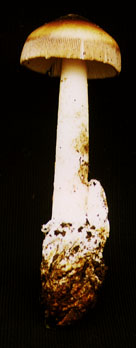Amanita pachycholea
 Otherwise known as the Western Grissette, this is a delicious fishy
tasting Amanita that grows among oak and Douglas fir in the coastal California
mountains. As with all Amanitas, you MUST practice extreme caution in your
identification, and don't eat one unless you really know what you are doing.
This mushroom may be confused with the deadly Amanita phalloides,
if you don't check for all of the important features. Look for the following
characteristics: 1) clear deep striations on the margin of the cap; 2) a
voluminous volva that fully enshrouds the base, sometimes reaching two to
three inches up the stalk of the mushroom; 3) bronze-colored tints on the
volva; 4) chestnut brown cap color (never greenish!) darkening in the center;
and 5) a pronounced fishy smell, especially in mature specimens. In my experience,
the fishy smell seems to be the most confidence - inspiring of the above
signs, especially as it resembles the smell of other edible amanitas, including
A. ceasarea, A. calyptrata, and A. velosa. Some people find this
smell to be a bit strong and unpleasant, but it truly mellows upon cooking,
and transforms into a rich nutty flavor with only the slightest traces of
fish. This is a wonderful large and fleshy mushroom, a joy to cook with.
Try it in cream sauces with a bit of nutmeg, or as a substitute for scallops
in Chinese cuisine. Here's one recipe that uses Amanita pachycholea:
Salmon grisette pasta.
Otherwise known as the Western Grissette, this is a delicious fishy
tasting Amanita that grows among oak and Douglas fir in the coastal California
mountains. As with all Amanitas, you MUST practice extreme caution in your
identification, and don't eat one unless you really know what you are doing.
This mushroom may be confused with the deadly Amanita phalloides,
if you don't check for all of the important features. Look for the following
characteristics: 1) clear deep striations on the margin of the cap; 2) a
voluminous volva that fully enshrouds the base, sometimes reaching two to
three inches up the stalk of the mushroom; 3) bronze-colored tints on the
volva; 4) chestnut brown cap color (never greenish!) darkening in the center;
and 5) a pronounced fishy smell, especially in mature specimens. In my experience,
the fishy smell seems to be the most confidence - inspiring of the above
signs, especially as it resembles the smell of other edible amanitas, including
A. ceasarea, A. calyptrata, and A. velosa. Some people find this
smell to be a bit strong and unpleasant, but it truly mellows upon cooking,
and transforms into a rich nutty flavor with only the slightest traces of
fish. This is a wonderful large and fleshy mushroom, a joy to cook with.
Try it in cream sauces with a bit of nutmeg, or as a substitute for scallops
in Chinese cuisine. Here's one recipe that uses Amanita pachycholea:
Salmon grisette pasta.
 Otherwise known as the Western Grissette, this is a delicious fishy
tasting Amanita that grows among oak and Douglas fir in the coastal California
mountains. As with all Amanitas, you MUST practice extreme caution in your
identification, and don't eat one unless you really know what you are doing.
This mushroom may be confused with the deadly Amanita phalloides,
if you don't check for all of the important features. Look for the following
characteristics: 1) clear deep striations on the margin of the cap; 2) a
voluminous volva that fully enshrouds the base, sometimes reaching two to
three inches up the stalk of the mushroom; 3) bronze-colored tints on the
volva; 4) chestnut brown cap color (never greenish!) darkening in the center;
and 5) a pronounced fishy smell, especially in mature specimens. In my experience,
the fishy smell seems to be the most confidence - inspiring of the above
signs, especially as it resembles the smell of other edible amanitas, including
A. ceasarea, A. calyptrata, and A. velosa. Some people find this
smell to be a bit strong and unpleasant, but it truly mellows upon cooking,
and transforms into a rich nutty flavor with only the slightest traces of
fish. This is a wonderful large and fleshy mushroom, a joy to cook with.
Try it in cream sauces with a bit of nutmeg, or as a substitute for scallops
in Chinese cuisine. Here's one recipe that uses Amanita pachycholea:
Salmon grisette pasta.
Otherwise known as the Western Grissette, this is a delicious fishy
tasting Amanita that grows among oak and Douglas fir in the coastal California
mountains. As with all Amanitas, you MUST practice extreme caution in your
identification, and don't eat one unless you really know what you are doing.
This mushroom may be confused with the deadly Amanita phalloides,
if you don't check for all of the important features. Look for the following
characteristics: 1) clear deep striations on the margin of the cap; 2) a
voluminous volva that fully enshrouds the base, sometimes reaching two to
three inches up the stalk of the mushroom; 3) bronze-colored tints on the
volva; 4) chestnut brown cap color (never greenish!) darkening in the center;
and 5) a pronounced fishy smell, especially in mature specimens. In my experience,
the fishy smell seems to be the most confidence - inspiring of the above
signs, especially as it resembles the smell of other edible amanitas, including
A. ceasarea, A. calyptrata, and A. velosa. Some people find this
smell to be a bit strong and unpleasant, but it truly mellows upon cooking,
and transforms into a rich nutty flavor with only the slightest traces of
fish. This is a wonderful large and fleshy mushroom, a joy to cook with.
Try it in cream sauces with a bit of nutmeg, or as a substitute for scallops
in Chinese cuisine. Here's one recipe that uses Amanita pachycholea:
Salmon grisette pasta.